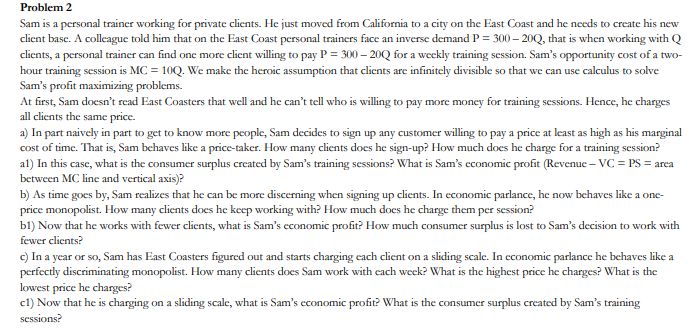Problem 2 Sam is a personal trainer working for private clients. He just moved from California to a city on the East Coast and he needs to create his new client base. A colleague told him that on the East Coast personal trainers face an inverse demand P = 300-20Q, that is when working with Q clients, a personal trainer can find one more client willing to pay P = 300- 20Q for a weekly training session. Sam's opportunity cost of a two- hour training session is MC = 10Q. We make the heroic assumption that clients are infinitely divisible so that we can use calculus to solve Sam's profit maximizing problems. At first, Sam doesn't read East Coasters that well and he can't tell who is willing to pay more money for training sessions. Hence, he charges all clients the same price- a) In part naively in part to get to know more people, Sam decides to sign up any customer willing to pay a price at least as high as his marginal cost of time. That is, Sam behaves like a price-taker. How many clients does he sign-up? How much does he charge for a training session? al) In this case, what is the consumer surplus created by Sam's training sessions? What is Sam's economic profit (Revenue - VC = PS = area between MC line and vertical axis)? b) As time goes by, Sam realizes that he can be more discerning when signing up clients. In economic parlance, he now behaves like a one- price monopolist. How many clients does he keep working with? How much does he charge them per session? b1) Now that he works with fewer clients, what is Sam's economic profit? How much consumer surplus is lost to Sam's decision to work with fewer clients? c) In a year or so, Sam has East Coasters figured out and starts charging each client on a sliding scale. In economic parlance he behaves like a perfectly discriminating monopolist. How many clients does Sam work with each week? What is the highest price he charges? What is the lowest price he charges? cl) Now that he is charging on a sliding scale, what is Sam's economic profit? What is the consumer surplus created by Sam's training sessions







